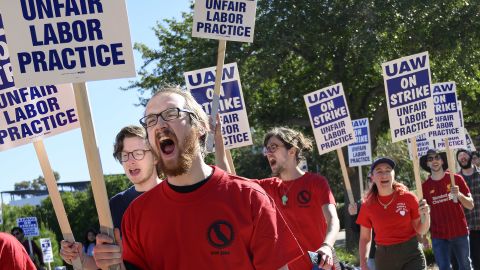Macklem made the remarks during a speech before the Public Policy Forum in Toronto on Thursday.
“The tightness in the labour market is a symptom of the general imbalance between demand and supply that is fuelling inflation and hurting all Canadians,” he said.
Canada added 108,000 jobs in October, while unemployment remained steady at 5.2 per cent.
You can read Macklem's full remarks below.
Good morning. It’s great to be back in Toronto to discuss an issue that matters to everyone—the Canadian labour market. I’m particularly pleased to be on a university campus for a speech that explores the future of workers and jobs. And I want to thank the Public Policy Forum for inviting me to engage with students, researchers and thought leaders on this important issue.
My Governing Council colleagues and I meet with stakeholders of all kinds—business leaders and community groups, unions and students. And everywhere we go, we get many of the same questions. First, people ask about inflation and interest rates. Controlling inflation is our top priority, and I’ll get into that today. Everyone also wants to talk about jobs and the labour market, and three questions regularly come up: Why can’t businesses find enough workers? Are we going into a recession, and does that mean a big rise in the unemployment rate? And what is the Bank of Canada’s role in supporting maximum sustainable employment?
So today I want to address these questions. I will tackle them in three parts. First, I want to outline how inflation and the labour market are linked. I’ll explain that returning to low and stable inflation is the best way to achieve maximum sustainable employment. Our mandate is explicit about that. Second, I want to highlight how the Canadian labour market was hit by COVID-19, how it recovered and what we expect in the coming months. Finally, I want to discuss structural changes in the labour market, such as the aging of the population, that we’d be grappling with even if the pandemic hadn’t happened. I will discuss what we are watching and what Canadian governments and businesses can do to help grow the supply of labour.
OUR MANDATE
Since the Bank was founded, its mandate has been to promote the economic and financial welfare of Canada. As we said when we renewed our monetary policy framework last December, the Government of Canada and the Bank believe that the best contribution monetary policy can make to the well-being of Canadians is to deliver price stability. This is formalized with an inflation target, which is the 2% midpoint of a 1% to 3% inflation-control range.
The Government and the Bank also agree that monetary policy should continue to support maximum sustainable employment. We recognize that maximum sustainable employment is not directly measurable and is determined largely by non-monetary factors that can change through time. This reflects the reality that maximum sustainable employment is more of a concept than a number. In practice, knowing when we’ve reached it is difficult because we have to infer where it is, and labour market indicators give us clear signals only when we are well above or below it.
Finally, well-anchored inflation expectations are critical to both price stability and maximum sustainable employment. That’s why the Government and the Bank agree that the primary objective of monetary policy is to maintain low, stable inflation over time.1 What I want to stress here is that maximum sustainable employment and inflation close to the 2% target go hand in hand. If employment is well below its maximum sustainable level, the economy is missing jobs and incomes, and spending will be below the economy’s productive capacity. This puts downward pressure on inflation, pushing it below the target. That’s what happened early in the pandemic. If the economy is operating above maximum sustainable employment, businesses won’t be able to find enough workers to keep up with demand, putting upward pressure on prices and pushing inflation above the target. That’s where we are today.
At almost 7%, inflation is well above our 2% target. Inflation in Canada partly reflects global factors—sharply higher prices for many commodities and internationally traded goods. But much of the inflation we are experiencing reflects domestic factors—namely, excess demand in the Canadian economy. Our economy is overheated. Job vacancies are elevated, and businesses are reporting widespread labour shortages. Over the last six months, wage growth has increased and broadened across the economy. The unemployment rate in June hit a record low—and while that seems like a good thing, it is not sustainable. The tightness in the labour market is a symptom of the general imbalance between demand and supply that is fuelling inflation and hurting all Canadians.
Since March, we have been raising our policy interest rate to help bring inflation back to our target. Higher interest rates will work to slow spending and labour demand in the economy, and over time, this will relieve domestic inflationary pressures.
We’re trying to balance the risks of over- and under-tightening monetary policy. If we don’t raise interest rates enough, Canadians will continue to endure high inflation, and high inflation will become entrenched, requiring much higher interest rates and a sharper slowing in the economy to restore price stability. If we raise interest rates too much, the economy will slow more than it needs to, unemployment will rise considerably, and inflation will undershoot our target. Getting the balance just right is no easy task, and I want to explain what we’ll be watching in the labour market as we make monetary policy decisions in the months ahead.
That starts with a look at the upheaval of the pandemic and what Canadian workers have been through over the last two and a half years.
Deep recession, rapid recovery and excess demand
The recent history of the labour market can be broken into three distinct phases: pandemic-related economic shutdowns, the recovery that came with re-opening, and the current environment of excess demand. Let me address each of these in turn.
THE PANDEMIC SHOCK
The COVID-19 pandemic caused the biggest global downturn since the Great Depression. Much of the economy shut down to contain the spread of the virus, and millions of people lost their jobs. In Canada, we plunged into the deepest recession on record, and the effects were devastating. Roughly 3 million people who were employed before the pandemic were out of work by April 2020. And another 2.5 million were working less than half of their usual hours. The shock hit workplaces from coast to coast to coast.
But it hit very unequally. Work that required close contact with people—mainly in the services sector—was shut down. That disproportionately affected youth, women and low-wage workers. The closure of schools and daycares also hit women with young children harder, and they experienced a greater decline in their hours worked.
Never before has so much of the economy been shut down so suddenly and for so long. We were very concerned that it would result in scarring. In other words, we worried that damage to the incomes and careers of a whole segment of the population, particularly women, youth and immigrants, would be permanent.
THE RECOVERY
That brings me to the second phase: the fastest recovery ever. Do you remember that first year of the pandemic? We couldn’t travel abroad or even much within Canada, so we stayed home. We renovated our homes to accommodate working and studying remotely, and we bought many goods to replace the fun we’d normally get from the services sector.
Just four months after the employment lows of April, nearly two-thirds of the job losses were recouped (Chart 1). What was behind the rapid bounce back? It was largely because the recession came from an unprecedented event—the pandemic—and not from imbalances or structural problems in the economy. That meant that when the economy reopened, employment could be restored quickly. We expected a rapid rebound in employment with reopening, but we were concerned that too many people would be left behind. Fortunately, the scarring we were worried about wasn’t as pervasive as we had feared because employment recovered quickly.
The synchronous policy response of governments and central banks around the world played a big role in supporting the recovery. In Canada, fiscal policies were designed to help keep workers attached to their employers and businesses afloat even with little money coming in.2 That limited damage to the labour market. Monetary policy actions complemented these fiscal policies. We cut policy interest rates and introduced quantitative easing to reduce borrowing costs, which supported spending and helped restore employment.
The reopening of schools and daycares helped too. As schools returned to in-class teaching, mothers went back to work. This reduced the uneven impact of the pandemic, but it did not eliminate it.3
As the vaccination rate increased and the economy reopened, those employed in goods-producing industries returned to work sooner than those engaged in hard-to-distance services.4 And sectors where remote work is effective—such as professional services, public administration and finance, and insurance and real estate—experienced employment well above their pre-pandemic levels, while employment in services sectors such as hotels and restaurants remained much below.
Overall, this rapid pace of the recovery is unheard of, far faster than in past recessions.
EXCESS DEMAND
That brings me to 2022 and our current labour market. We are in excess demand, where the economy’s need for labour is outpacing its ability to supply it. At the end of last year, it was not obvious that the labour market would rapidly overheat in 2022. The Omicron variant was spreading, and COVID-19 case numbers were once again rising. But looking through the volatility in the labour market caused by waves of the pandemic, we can now see a clear trend of an increasingly tight labour market in 2022. Employment growth remained strong, reports of labour shortages increased, and wage growth picked up.
To meet rising demand, employers reached more deeply into the labour market, and they found some new workers. Hiring of immigrants—especially recent immigrants—increased, easing employment gaps between these workers and Canadian-born prime-age workers.5 Pandemic innovation and strong labour markets also brought more flexibility to some jobs, partly due to digitalization accelerated by the pandemic. Employers could more easily accommodate workers in remote locations or those who needed flexible hours. Long-term unemployment, which rose sharply during the pandemic, returned to its pre-pandemic levels.
We began raising our policy interest rate in March to cool this overheated economy, but the momentum in the labour market held. Employment gains continued, and labour shortages intensified through the spring. The unemployment rate reached a record low 4.9% in June. Job vacancies exceeded one million in the second quarter—a new record. Rising vacancies with low unemployment were clear signs that the economy was out of balance, with demand running ahead of supply.
In recent months, we’ve seen initial signs that these exceptionally tight labour market conditions have started to ease. Since the spring, employment has levelled off, and the unemployment rate has crept up a little, to 5.2%. Wage growth has risen but now looks to be plateauing. Job vacancies have started to decline. Their softening has been evident in sectors that are more sensitive to interest rates, such as manufacturing and construction (Chart 2).
Looking ahead to balance
As we look ahead, there are two elements to achieving a better-balanced labour market: demand and supply. Demand for labour needs to moderate so supply can catch up. And the more the labour supply grows over time, the less slowing is needed in labour demand to restore and maintain price stability.
Labour demand
The first part—slowing demand—is what we influence with interest rate increases. Generally, low unemployment and high demand for workers benefit Canada’s economy. Good jobs are the best way to reduce inequality and ensure that Canadians have the income they need to meet the needs of their families. But right now, we need the economy to slow down. With more modest spending growth, the demand for labour by businesses will ease, vacancies will decline, and the labour market will come into better balance. This will relieve price pressures.
Increasingly, we hear concerns that Europe, the United States and even Canada are heading for a recession. In our Business Outlook Survey released a few weeks ago, a majority of Canadian firms surveyed said a recession is likely in the next 12 months. As we said in our October Monetary Policy Report, we expect growth to stall in the next few quarters—in other words, growth will be close to zero. That means two or three quarters of slightly negative growth are just as likely as two or three quarters of slightly positive growth. That’s not a severe recession, but it is a significant slowing of the economy.
Slower economic growth will likely lead to higher unemployment. We know that job losses have a human cost. But because the labour market is so hot and we have an exceptionally high number of vacant jobs, there is scope to cool the labour market without causing the kind of large surge in unemployment that we have typically experienced in recessions.
As we use higher interest rates to cool inflation, we’ll be watching very closely for signs that the economy and the labour market are responding. One way to explore the needed adjustment in our labour market is through the lens of what economists call the Beveridge curve. This curve depicts the typically inverse relationship between job vacancies and unemployment (Chart 3).
As job vacancies decline, unemployment usually goes up. But by how much? That depends on where the labour market is along the curve. Generally speaking, when job vacancies are high, as they are now, a decline in vacancies does not lead to as big an increase in unemployment as it does when job vacancies are low to begin with. Staff analysis of Canada’s Beveridge curve suggests that the unemployment rate will rise somewhat if the job vacancy rate returns to more normal levels. But it would not be high unemployment by historical standards.
So what does that mean for Canadian workers? Well, it’s clear that the adjustment is not painless. Lower vacancies mean it could take longer to find a job, and some businesses will find that with less demand for their products, they don’t have enough work for all their workers. But relieving the pressure in the labour market will contribute to restoring price stability.
We’ll be watching a broad set of indicators to gauge the health of the labour market and how it is adjusting to tighter monetary policy. As we watch to see how the economy is responding to higher interest rates, we expect that some parts of the economy will be more sensitive to higher borrowing costs and will slow earlier or more sharply. The response will be somewhat uneven. Some industries more than others will see fewer vacancies or even job losses. We’ll be looking beyond headline employment numbers to gauge how different groups in the labour market are adjusting. Last year, we launched our new dashboard of indicators to help us assess the overall health of the labour market and where we are relative to maximum sustainable employment.
LABOUR SUPPLY
That brings me to the second component of getting back to balance: labour supply. The labour market is also being—and will continue to be—profoundly affected by supply-side developments that are beyond the scope of monetary policy. That brings us back to one of the frequently asked questions: “Where are all the workers?”
The short answer is most of them are working and some have retired. We now have half a million more people employed than we did before COVID-19 hit. But an increase in retirements and less immigration early in the pandemic have reduced labour force growth. That’s another reason the labour market is so tight. These demographic shifts have played a big role in the supply of labour. In Canada, as in many advanced economies, the age group that grew the fastest in recent years was those aged 65 and over. That’s not pandemic-related, it’s simply the aging of the baby boomers. Those over 65 tend to have the lowest labour force participation rate, and that has been pulling down the growth of Canada’s labour force in recent years.
Immigration has typically helped Canada’s labour force grow. But the pandemic disrupted immigration flows. Borders closed, and Canada fell short of its 2020 immigration target by about 156,000 people, or an estimated 100,000 workers.
Fortunately, immigration is bouncing back as border restrictions return to normal. Canada met its immigration target of 401,000 in 2021. And, based on the increase in the immigration targets since then, the shortfall in permanent residents caused by the pandemic should be recouped in 2023.9 Many advanced economies whose populations are aging are looking to increased immigration to meet the needs of their labour markets. But because of relatively higher immigration targets, Canada will have an advantage in coming years—Canada’s population growth is expected to far exceed that of other G7 countries (Chart 4).
This is a key reason why the growth outlook in our October Monetary Policy Report exceeds that of some of our peers, including the United States. The strong immigration targets suggest that net immigration will account for over two-thirds of the expected growth in Canada’s potential output.
The strength of the labour market has helped improve outcomes for recent immigrants. We can also increase participation by other workers, including women, if we leverage the changes that these tight labour markets have brought. We can further reduce the long-standing gap between prime working-age women and men. The pandemic showed us how important child care is—when it disappeared, so did many female workers. Canada’s female participation rate is higher than that of the United States. But other countries have higher female participation than we do—we’re only just above the median of member countries of the Organisation for Economic Co-operation and Development for participation of women aged 25 to 54, ranking 16th out of 38 in 2021. Improvements to universal child care may narrow these differences, though the full effects will take time.
Other populations may also benefit from improved labour market access, including Indigenous people, who have a younger and faster-growing population than many other groups. Potential for remote work, as well as training to develop skills in areas with critical labour shortages, may open new opportunities for groups facing local labour market challenges. And companies need to do their part to attract and retain new segments of the labour force.
By adjusting to and taking advantage of structural changes in the labour market, Canada can increase the sustainable growth rate of our economy. An aging population reduces the participation rate, and higher immigration is becoming increasingly important for Canada’s potential growth. Changes brought by globalization and technological change, especially digitalization, will also continue to affect labour demand and the skills employers need. The net effect on maximum sustainable employment is something we will be working to assess.
An increased supply of workers raises the rate the economy can grow without generating inflationary pressures. But enhancing supply takes time. It also creates new demand. New workers will have new incomes, and that will add to spending in the economy. That’s why increasing supply, while valuable, is not a substitute for using monetary policy to moderate demand and bring demand and supply into balance.
CONCLUSION
It’s time for me to conclude.
Since the onset of COVID-19, the labour market has been in tremendous turmoil. The pandemic caused a surge in unemployment and had a terribly uneven impact, exacerbating the inequality already faced by women, youth and marginalized workers. We were very concerned about widespread job losses, deep cuts in consumer spending and, ultimately, deflation. But the recovery was swift and across the board, with the fastest rebound in employment ever. Now the economy has gone too far in the other direction. The economy is in excess demand, the job market is too tight, and inflation is too high. Monetary policy has begun to have an impact, but it will take time for the effects of higher interest rates to spread through the economy and reduce demand and inflation.
Once we get through the slowdown, growth will pick up and our economy can grow solidly again with healthy employment and low inflation. How much employment growth we can achieve while maintaining low inflation will depend on the growth of labour supply. This is the fundamental concept that maximum sustainable employment captures. It is not maximum employment—it’s how much employment the economy can sustain while maintaining price stability. As I said earlier, you can’t have one without the other.
Growing maximum sustainable employment is a shared responsibility of government, businesses and workers. Increased immigration adds potential workers, and governments need to ensure newcomers have a smooth path into the workforce, with credential recognition and settlement support like language and skills training. Businesses need to invest in training so we can reduce the skills mismatch. And workers need to invest in gaining the skills the new economy needs.
Our priority at the Bank of Canada is to restore price stability. The overriding imperative is to ensure that high inflation does not become entrenched because, if that happens, nothing works well. This was the experience of the 1970s.11 The failure to control inflation resulted in high inflation and high unemployment. Labour strife increased as workers tried to cope with large increases in the cost of living. And ultimately it took much higher interest rates, and a severe recession with a large increase in unemployment, to rein in inflation and re-anchor inflation expectations. That is exactly what everyone wants to avoid.
That’s why we have front-loaded our interest rate increases. And that’s why we are resolute in our commitment to return inflation to the 2% target. To get there, we need to rebalance the labour market. This will be a difficult adjustment. We want to do this in the best way possible for Canadian workers and businesses. Higher interest rates will help cool spending and the demand for labour in the economy. This will give supply time to catch up, relieving price pressures. We will be monitoring a wide range of indicators to assess this rebalancing and Canada’s sustainable growth rate. Canada has some advantages that will help support our labour supply, creating more capacity for growth.
The best contribution monetary policy can make to a healthy labour market is to deliver price stability. With inflation and inflation expectations well anchored on the 2% target, our economy, our workers and our businesses will be positioned for growth and prosperity.
Thank you.
I would like to thank Mikael Khan and Corinne Luu for their help in preparing this speech.
With files from The Canadian Press







